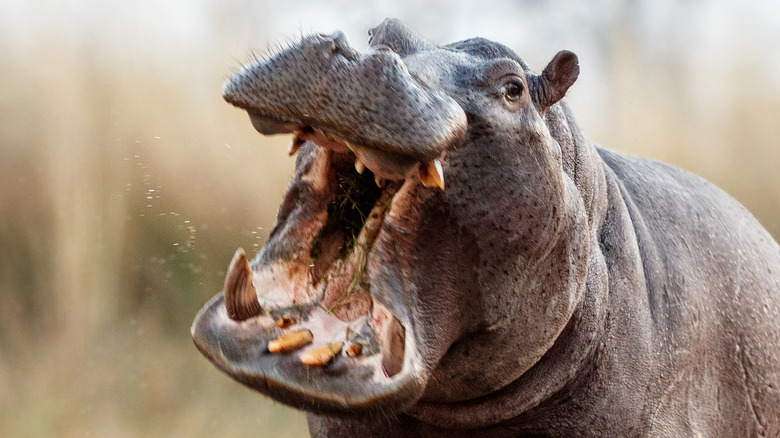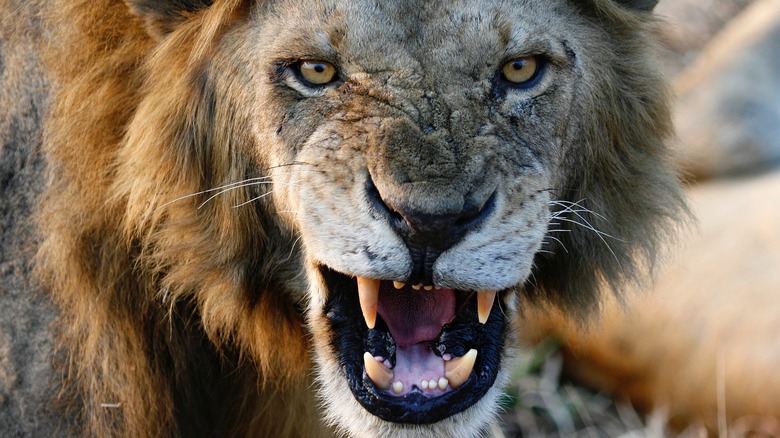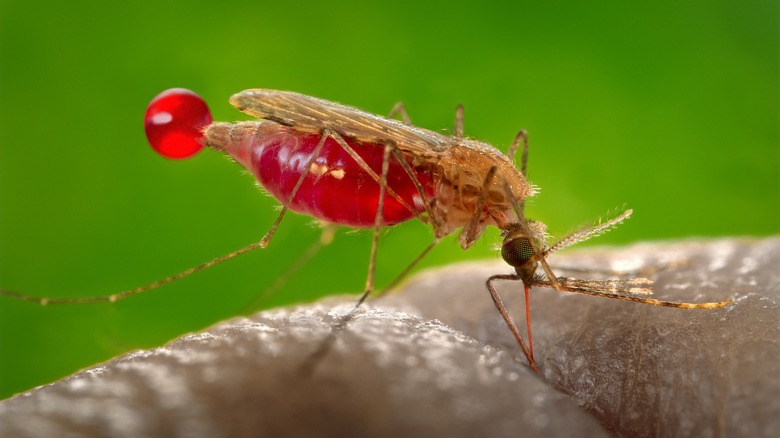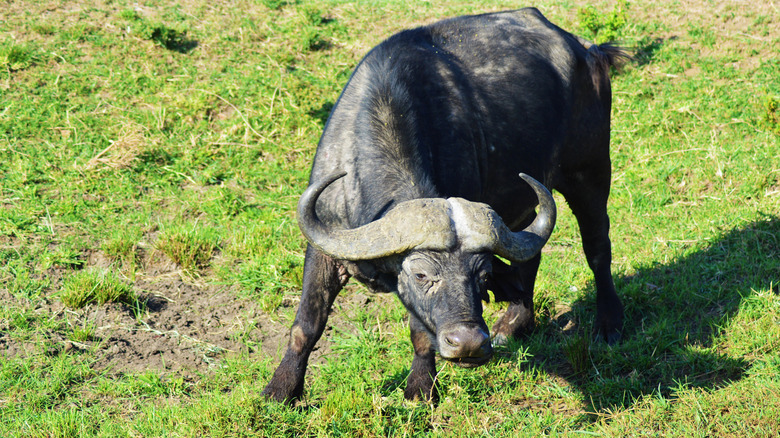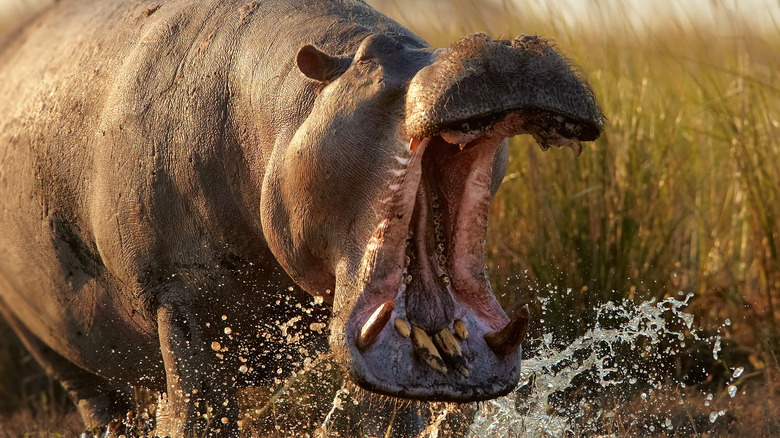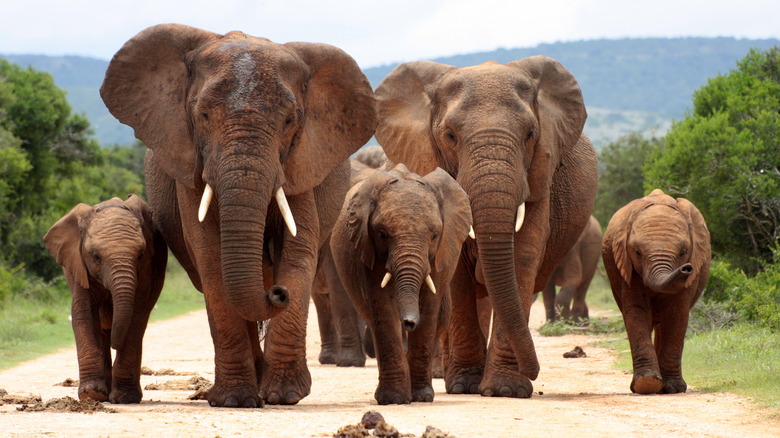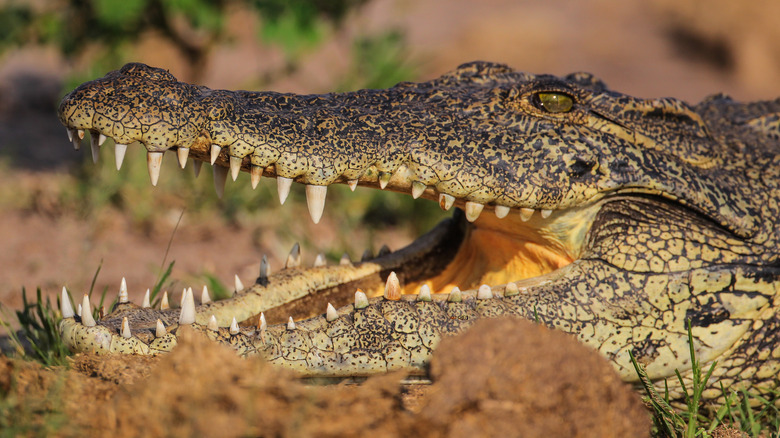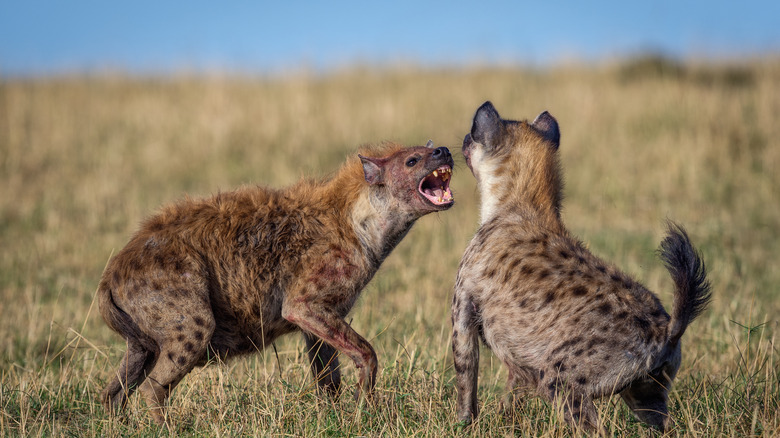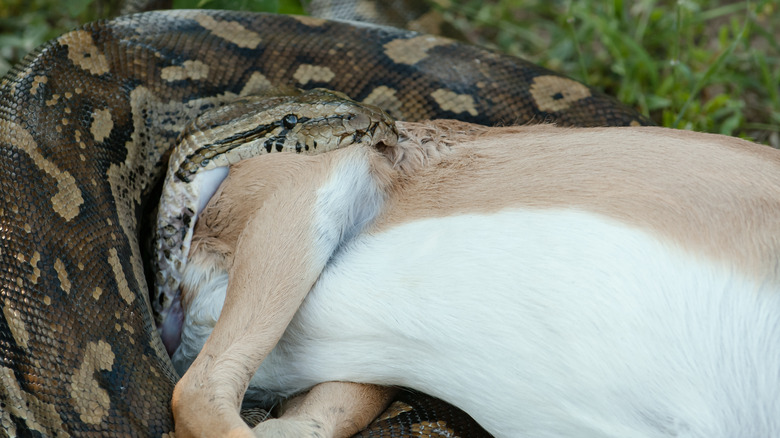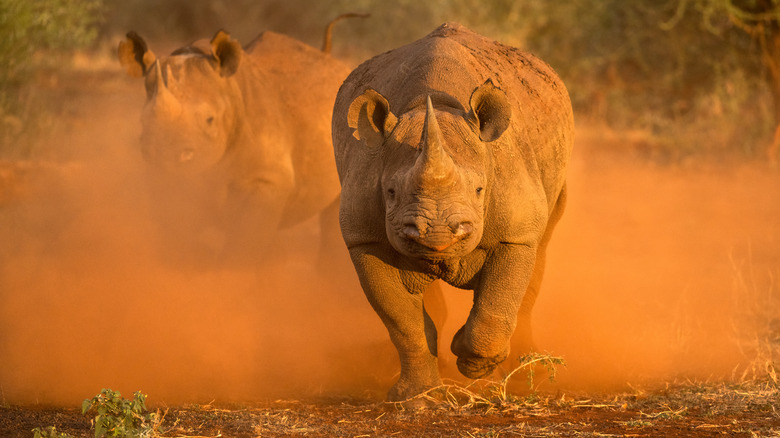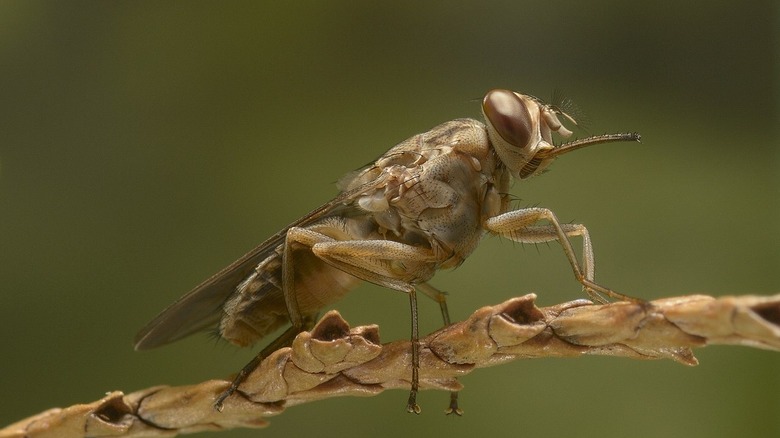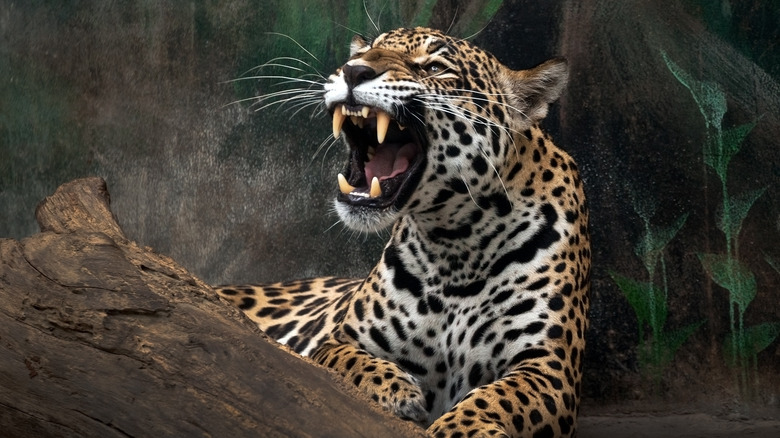Most Dangerous Animals In Africa
Africa is often seen as a reservoir of life. It is a place where large animals still roam free in great numbers. It is a continent which has aroused the imagination of millions, if not billions, of people worldwide through scientific documentaries and tales. The allure of the great animals of Africa is exciting. But don't get too close, since many of these animals are quite dangerous.
According to the World Wildlife Fund, game hunters have traditionally referred to Africa's "Big Five." These were animals that hunters considered difficult and dangerous to hunt: leopard, elephant, lion, rhinoceros, and buffalo. These animals certainly make the cut of the most dangerous animals in Africa, but it may be surprising that some of the most dangerous on the continent are tiny insects, and that others have been portrayed by Disney as dancing in tutus.
In any event, almost all of the most dangerous animals in Africa are in danger themselves. Habitat encroachment and poaching have pushed these animals to the edge. In doing so, they have come into closer contact with humans which results in nasty incidents which are good for neither human nor animal. So let's take a look at some of the most dangerous animals in Africa.
Black Mambas will poison you
Venomous snake bites take their heaviest toll in Africa. National Geographic reports the continent sees 500,000 people bitten by poisonous snakes per year, leading to about 30,000 deaths. Now while all venomous snakes are dangerous, there is none more dangerous in Africa than the Black Mamba. Mambas are a species of elapids, which also include cobras. These types of snakes deliver neurotoxins and cardiotoxins to their victims, which block the transmission of nerve signals and stops the heart. This paralyzes the respiratory system making it impossible to breathe.
The Black Mamba is a particularly deadly elapid. As recorded by National Geographic these snakes, which are up to 14-feet long, will raise themselves off the ground when threatened, spread their cobraesque hood, and strike multiple times delivering their extremely potent poison. If antivenom is not administered immediately, the death rate is near 100%. Usually, a person only has 20 minutes to live.
Part of the problem in Africa is that even though the continent has a large and diverse population of venomous snakes, its access to antivenom is low. This is because of the economics of antivenoms. To produce a Black Mamba antivenom, you need to actually extract the venom of the serpent and then it needs to be highly processed in a lab environment. This is extremely expensive, and countries in Africa typically do not have the monetary resources to maintain a large and ready supply of antivenom.
Lions will eat you
As Africa's largest indigenous predator, lions are clearly among its most dangerous animals. Statistics provided by National Geographic show what you'd be facing if you encountered these big cats. Adult males can reach up to 420 pounds and wield nearly 4-inch canines. To survive, lions need to eat 15 pounds of meat per day but will greedily devour much more than that in one sitting since they don't get three square meals a day usually.
Lions are known to hunt humans. One example is the famous "Lions of Tsavo" who killed 35 railway workers (maybe many more) in Tsavo, Kenya. Lieutenant-Colonel John Henry Patterson, who eventually hunted them down, wrote in his memoir "The Man-Eaters of Tsavo" of what happened when the lions seized a railway worker at night and brought him toward his camp to eat: "I could plainly hear them crunching the bones, and the sound of their dreadful purring filled the air and rang in my ears for days afterwards." Theories abound as to what caused the attack including, as reported by National Geographic, disease or dental troubles.
Lion attacks used to amount to thousands of deaths. Recently, as reported by Britannica, deaths by lion attack in Tanzania amount to 100 per year. As lions have seen severe population declines due to human encroachment, the number of attacks have logically decreased. However, because humans and lions are coming into closer proximity, there may be more grisly reports of lion encounters in the future.
Mosquitoes will give you deadly diseases
The deadliest animal on the African continent is also the tiniest. Mosquitoes are commonly known to be a major vector for disease. "Mosquito-borne arboviruses of African Origin" reports that there are 36 types of viruses indigenous to Africa that are transmitted through female mosquito bites. These diseases include Zika, yellow fever, and especially forms of malaria.
According to the "Epidemiology of Malaria in Africa," the most common type of malaria transmitted by Anopheles mosquitoes in sub-Saharan Africa makes mosquitoes the hands down most dangerous African animal. The World Health Organization (WHO) in a 2021 report noted that of 229 million worldwide cases of malaria, 94% of them occurred in Africa. This would then mean that of the 409,000 yearly malaria deaths, almost all of them occur on the continent. Even more saddening is that 67% of these deaths are of children under the age of five. The top three countries most impacted by malaria are Nigeria, the Democratic Republic of the Congo, and Tanzania.
Malaria was once widespread globally but was mainly eliminated in temperate-climate countries by the mid-twentieth century. Proactive measures are the key to preventing these deaths. WHO recommends netting and indoor spraying to help control mosquitoes as a disease vector.
Cape Buffalo will gore you
One of the most dangerous animals in Africa is related to cows. According to National Geographic, the 1,500-pound, dark-hided Cape Buffalo lives in herds of anywhere from 50 to 500 individuals and are very testy and unpredictable when disturbed. Cape Buffalo instinctively behave defensively when they sense hostility and will often pursue a perceived threat. "The World's Most Dangerous Animals" reports that whole herds have been known to take on multiple lions in order to protect an individual. If you get on the wrong side of a Cape Buffalo, you might find it barreling at you at 37 miles per hour with its sharp, curved horns being the last thing you'll ever see. And even if you manage to wound one, a Cape Buffalo is more likely to keep coming at you than to run away. About 200 people per year are killed by Cape Buffalo.
Hunters often pay the ultimate price when approaching Cape Buffalo. For example, the Independent reported that in 2018, 54-year-old big game hunter Claude Kleynhans had just shot and killed a buffalo when another member of the herd came at him. He was taken unawares, while he was loading his kill onto his truck. The buffalo cut his femoral artery, killing him almost instantly. It is for incidents such as this that these animals are nicknamed "the Black Death."
Hippopotamuses will drown you and bite your head off
When dealing with hippopotamuses one should not be lulled into a false sense of security created by too many viewings of Disney's dancing hippos from "Fantasia." Hippos will kill you. As explained by Live Science, adult males can reach over 9,000 pounds and are the third largest land mammal in the world. Most of their time is spent in water in large groups where they keep their skin moist, only coming out at night to graze. While in the past, it has been assumed that these powerful animals were purely herbivorous, studies have shown that when pressed they will scavenge on carcasses, including their own species.
What makes hippos especially dangerous is that they are territorial and aggressive. They are especially dangerous in water where they are much faster than you would think. Hippos have been videoed chasing speedboats! People who stumble into a hippo's territory may find themselves at odds with the animal's immense tusks and teeth which can make quick work of a boat or a person. Hippos have been reported to bite people's heads off. As reported by the Washington Post, in 2014 one or more hippos killed 12 children and an adult after it flipped their boat in Niger. Hippos also have attacked herds of cattle, trampling crops and preventing fishing. One villager from Gouloumbou, Senegal called them "evil monsters."
It is estimated that 500 people per year die from hippo attacks.
Elephants will trample you
Are the largest terrestrial land animals in the world dangerous? You bet.
The African elephant, which National Geographic reports can reach up to 7 tons, is a keystone species in Africa. Their powerful tusks dig up waterholes during the dry season, their dung fertilizes the soil and spreads seeds, and their massive bulk allows them to create paths for smaller creatures.
This large size means that elephants require a lot of calories. However, their habitat is increasingly being taken from them by humans which brings them increasingly into conflict. The World Wildlife Fund reports that even a solitary elephant can make short work of a hectare of farmland. Often farmers will shoot elephants in retaliation for crop damage, but sometimes elephants will kill farmers instead. Even one swipe will kill a person because of their sheer bulk. In one example, the BBC reported in 2017, Theunis Botha was crushed to death after a female elephant picked him up with his trunk after being shot. Britannica estimates that up to 500 people per year are killed by elephants.
Nile Crocodiles will seize, drown, and shred you
Even though they are called Nile Crocodiles, they live in almost every major waterway in Africa. At up to 16 feet in length and weighing 500 pounds these animals have no qualms about grabbing anything that comes near them, including humans. As National Geographic mildly puts it, "The Nile crocodile has a somewhat deserved reputation as a vicious man-eater."
A Nile Crocodile attack is in its own league of terrible ways to die. As related in Scientific American, the crocodile is an active hunter that remains virtually out of sight, being that when submerged only its nostrils and eyes appear above water, usually to check to see if the intended meal is still there. Then it will lunge suddenly for its prey, often leaping several times its body length out of the water to seize its unfortunate victim with its conical teeth. It then will crush the prey to death or, if too large, pull it back to the water to drown it. Then it is ripped apart by twisting and tossing to allow chunks of flesh to be severed from the corpse. Crocodiles do not chew.
About 200 deaths per year are attributed to Nile Crocodiles, though the statistics are so sketchy it could be many more.
Spotted Hyenas will crush your bones like carrot sticks
Spotted hyenas have the bad historical reputation of being cowardly scavengers. However, as National Geographic points out they are extremely successful hunters. One zoologist observed hyenas make more active kills than lions. Working with their clans, they are very capable of bringing down large prey such as buffalo.
Aside from their sociability and intelligence, the jaws of the spotted hyena are its most incredible and dangerous weapon. As noted by The World's Most Dangerous Animals, the bite force of the spotted hyena is 1,100 pounds per square inch, putting it on par with crocodilians, gorillas, and hippos. In other words, a hyena can easily chomp right through elephant bone.
Attacks by spotted hyenas on humans are rare, but when they do happen they can be gruesome events. In the early 20th century, it was reported that hyenas killed those afflicted with sleeping sickness and packs were said to wait outside homes to pounce the moment the door opened. However, being at home may not ensure safety from hyenas. In 2020, CNN reported that a pack of hyenas dragged an 87-year old Zimbabwean man out of his mud and wood hut. By the time his fellow villagers found him, half his body was missing. As with all these large carnivores, habitat pressures will no doubt continue to raise the temperature of the conflict between humans and hyenas. Hyenas are also becoming a problem in urban areas. as reported by the BBC.
African Rock Pythons will squeeze you to death then eat you whole
The African Rock Python is Africa's largest species of snake and one of the most dangerous. This is not because it is venomous like the black mamba or puff adder, but because it is an ill-tempered, massive constrictor that has no compunctions about killing. According to National Geographic, these large snakes wrap around and squeeze their prey to death, then using incredibly flexible jaws swallow the victim whole. Heck, these reptiles have been videoed swallowing hyenas.
One grim incident as reported in the Journal of Herpetology occurred in 1979 when a 14-year old boy was caught by a Rock Python. The villagers first tried to rescue the boy by hitting the snake with a pickaxe, but the snake grabbed the handle of the tool in its mouth which caused the man to dislocate his shoulder and drop it. They finally got the snake off by throwing rocks at it. But it was too late, the boy was dead.
The largest African python measured came in at 9.8 meters (over 32 feet). These animals would easily be able to swallow a man. What is especially troubling is that African Rock Pythons are sometimes kept as pets. This has resulted in the strangling of two boys in Canada in 2013. There are other such incidents around the world, including threats of them becoming an invasive species in Florida.
Rhinoceroses will impale you
Rhinoceroses are highly dangerous, but statistically there are few reported incidents between them and humans. This is because rhinos are highly endangered due to poaching for their horns. According to the World Wildlife Fund, while rhino numbers have increased in some areas in recent years due to strict protections, the northern black and northern white rhinos are all but extinct.
Now if you happen to run into a rhinoceros, you should consider yourself lucky to see something so rare, but you should also be concerned about your personal safety. This is especially true if you come across a black rhinoceros, which is the more aggressive of the two African species. While admittedly, most rhinos are likely to run away rather than come at you, when they decide to — you better watch out. These animals, as detailed by National Geographic, can reach about 3,000 pounds, which according to Motortrend is about the weight of an average midsize sedan. Nobody wants to get hit by a midsize sedan — especially when it is bearing down on you with two sharp horns.
According to the Wilderness Medicine E-book, even clicking a camera could set off a charge. When it does come at you, the rhino tries to hook whoever the victim is by its horns to loft them into the air. You might think you can easily escape by side-stepping the lumbering beast. Guess again. Rhinos can turn on the spot and take you out before you can say "rhinoceros."
Tsetse flies will inject you with sleeping sickness
Trypanosomiasis, better known as African sleeping sickness, is a horrible way to die. As described by the World Health Organization, a victim becomes infected by a parasite that is carried by the tsetse fly. At first, one has fever, headaches, and swollen lymph nodes. Then in a second phase the parasite enters the brain and infects the nervous system. Aside from confusion and sensory deprivations, victims exhibit changes in behavior. Sleep is disrupted, thus giving the disease its name. According to the CDC, the acute East African variant of the disease will kill you in a matter of months without treatment. Where you are at most at risk are in rural areas.
Sleeping sickness was a tremendous problem in Africa, with epidemics breaking out until recently. In 1998, there were an estimated 300,000 cases of sleeping sickness, becoming at one point in certain countries the greatest cause of death. Continued efforts to control the disease have had some success, leading to there being only 992 reported cases in 2019. Still, the threat of the tsetse fly and the resurgence of sleeping sickness is a real one.
Leopards will ambush you
Leopards are highly successful predators who stalk and use ambush techniques to take down their prey. As noted by National Geographic, the beautiful spots on its coat, called rosettes, help conceal this big cat, which after making kills hauls its victims into trees for safety and leisurely eating. This reveals the leopard's incredible pound for pound strength, since they usually get up to around 176 pounds.
Leopards typically avoid human contact, and they are very good at hiding themselves. As Desmond Morris writes in "Leopard," "In the wild, like Shakespeare's dragon, it is more feared than seen — a sinister, lethal presence lurking unnoticed in the underbrush."
However, at times, African leopards will attack, even those most comfortable with wild animals. For example, the Guardian reported in 2015 that a leopard attacked a safari guide in South Africa's Kruger National Park who was in an open vehicle. Fortunately for the guide, the tourists accompanying him chased the leopard away by hitting it with their cameras and using another vehicle to run over the animal's legs.
